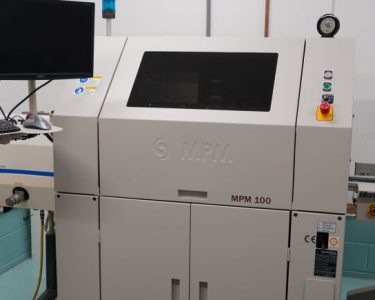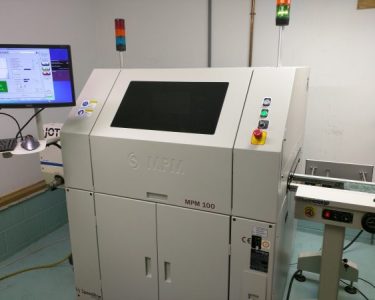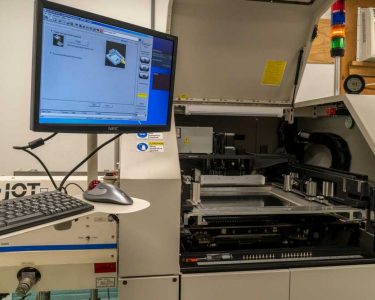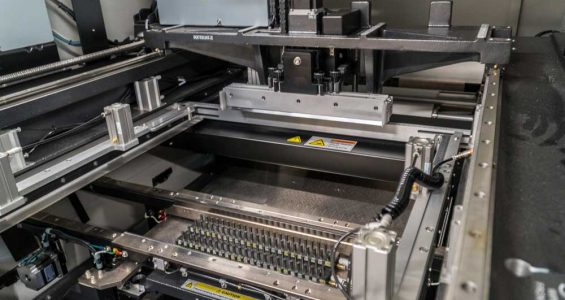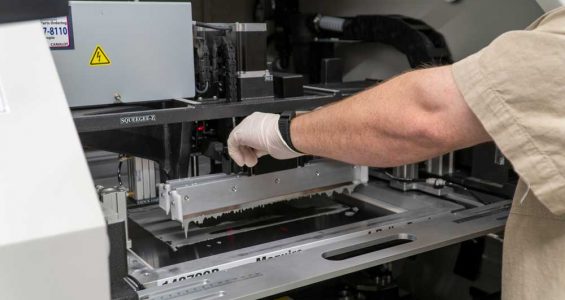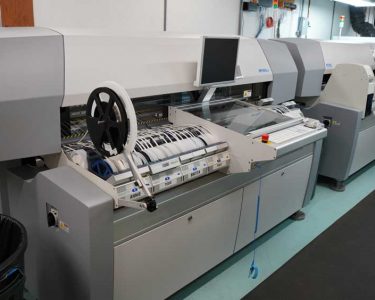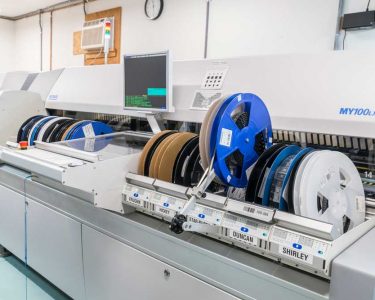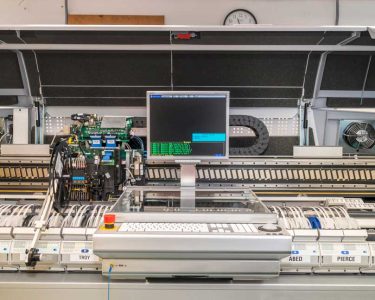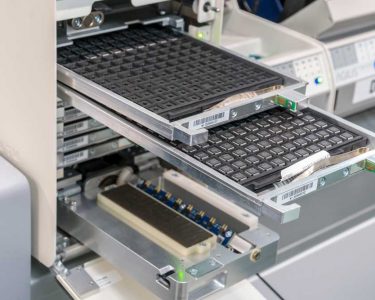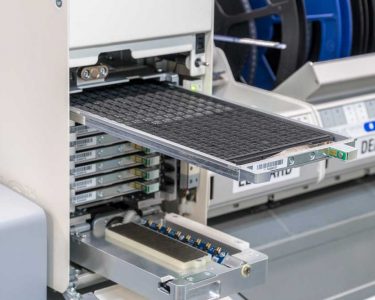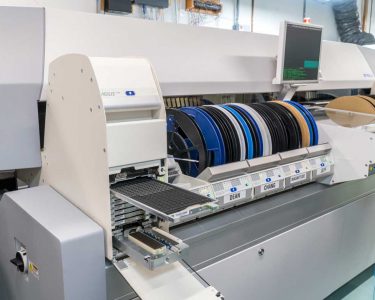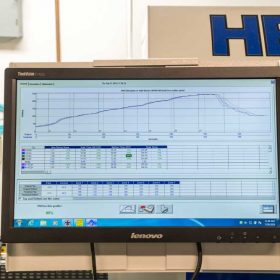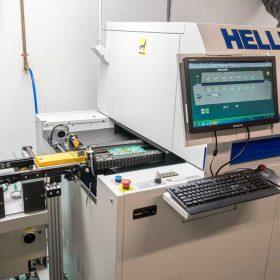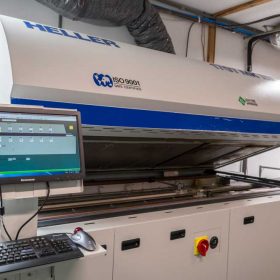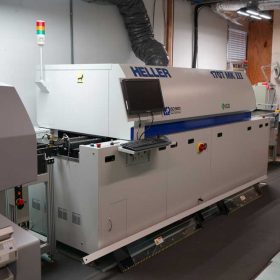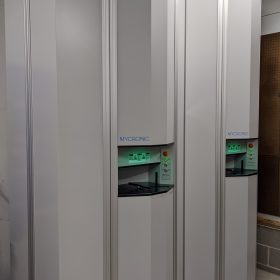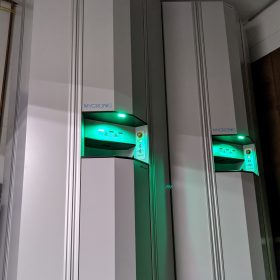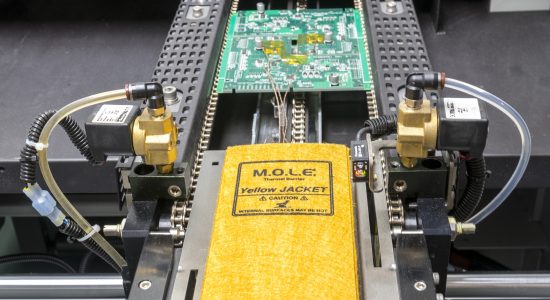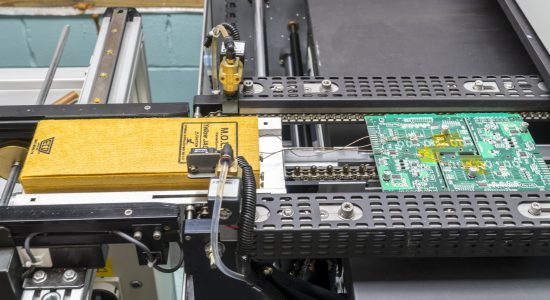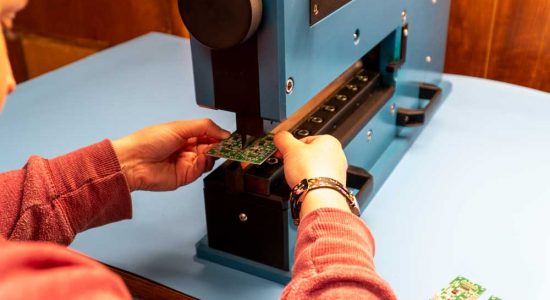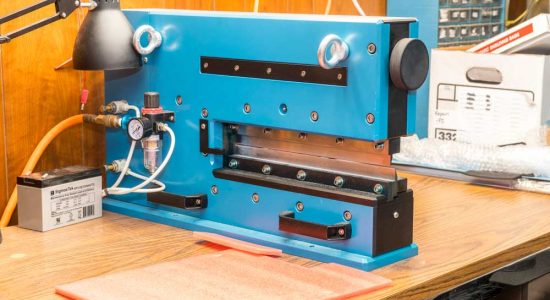Surface Mount Line
Our Surface Mount Line, or SMT Line, consists of an Ultrasonic Stencil Cleaner, a JOT PCB De-Stacker, an MPM Momentum 100 Screen Printer, two MYCRONIC MY100LXe Pick & Place machines, a Visual Inspection Station, and a Heller 1707 MKIII Reflow Oven. Some of the features that really set us apart are that we barely handle your PCBs, we have Electrical Verification, and we fully test the first board or panel off the line. We truly want our customers to only get the very best product.
Ultrasonic Stencil Cleaner
Typically, we use this stencil cleaning machine at the end of a production run, but I’m listing it here as it’s a crucial part of our process. If the solder paste stencil for a product isn’t clean, then incorrect amounts of paste will be dispensed causing errors. This cleaning station has a wand that uses sound/vibration to shake loose any pieces of old solder in the stencil’s apertures. We’ve seen improvement in our paste application ever since incorporating this station.
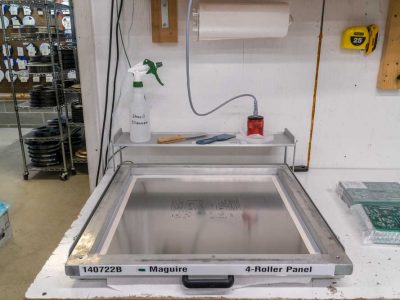
JOT PCB De-Stacker
The less we handle your boards during the manufacturing process, the better as humans can make mistakes like getting oil from your fingers on it or smearing paste. With our line and this de-stacker, we can place a large stack of boards on it and not touch these boards again until they’re out of the oven. The de-stacker does exactly what it says. It carefully takes a single board or panel from the bottom of the stack of boards and sends it to the MPM Screen Printer.
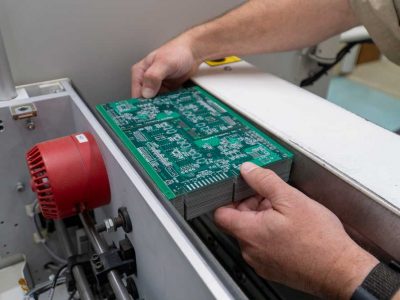
MPM Momentum 100 Screen Printer
This printer and its stencil are key parts to a good manufacturing process. We take extra care in making sure the solder stencil is tailored correctly for each component on the board. Once we start production, the machine uniformly applies solder paste to the bare board and then automatically inspects it for consistency and accuracy. Some of the great features of our MPM printer are fully automatic vision alignment, automated screening, pre and post automated paste inspection with reprint options, solder paste level sensor, and pneumatic board supports. With the pre and post paste inspections, we can be confident that every board is ready to move to the next step.
MYCRONIC MY100LXe Series Pick & Place
We have two of these machines and they are the heart of our production operation. They are set to “line” mode which means they divide the component placement work between the two machines, speeding up our manufacturing throughput. Each machine can place 16,000 CPH (components per hour) and together, can place a total of 32,000 CPH. As for component packaging, they handle cut tape, tape & reel, tube, and JEDEC tray components. For components themselves, we can place parts as small as 01005’s and as large as 56mm x 52mm with a maximum component weight of 140g. We can also handle a lot of odd shaped parts and parts with rounded or difficult pick points as we have both jaw and vacuum type tools available.
To further improve our operation, we purchased both the optional Electrical Verification feature and an upgrade kit that included a whole new vision system, software, and other internal components. This upgrade essentially made our MY100 Series machines into MY200 Series ones. We really try our best to keep up with the latest in manufacturing technology and practices.
Electrical Verification
This feature is installed in the MY100LXe Pick & Place machines. It gives them the ability to electrically verify the values of parts on the fly. There are some limitations, but you will know that the correct value for many parts has been placed on your product. The parts that we can electrically verify are resistors, capacitors (limited values), diodes (value and polarity), and some transistors (limited values).
We utilize this feature on all production and set it to test the first 3 parts picked from every feeder. Once that’s complete, the machine will assume the part is valid until the magazine containing that reel of parts is removed. When the magazine is plugged back in, it will re-verify all feeders in that magazine. Our default is set to the first 3 parts, but that value can be increased, decreased, or set to verify all parts if that is our client’s wish. The only downside is that the more parts we verify, the slower our product throughput will be. That said, it’s a wonderful feature that increases customer confidence and is especially useful for medical or military customers who need heavy traceability.

ATM8 Agilis Feeder
We’re proud to announce another new upgrade for our MY100LXe machines. This ATM8 feeder allows us to use up to 8 JEDEC trays worth of parts. Our original feeder could only handle 4, so we’ve doubled our capabilities. This is important because JEDEC are how most microprocessors, wireless modules, etc. are packaged. Since we’re seeing more complex chips on a single board, we knew we’d eventually outgrow our 4 tray limit.
MyCenter
MyCenter is a sophisticated software suite that acts as both an inventory control system and a programming/setup system for MyCronic equipment. The inventory control side allows us to accurately store, locate, and track parts in our SMT inventory. The ease of this system lies in its usage of barcodes to load, unload, and track both locations and quantities for every part on each MY100LXe machine. The programming/setup side allows us to create new parts, edit layouts, edit pick and place programs, etc. for the MY100LXe machines. Other important features of MyCenter are the ability to maximize production run efficiency, calculate quantity of boards we can produce with a given inventory, and notify us if we need more parts for a scheduled job. MyCenter will also easily integrate with the two 6150-7 SMD Towers coming this fall.
Heller 1707 MKIII Oven
Our Heller reflow oven is 134” long and has 7 separate zones with a temperature accuracy of +/- 0.1°C. This allows us run excellent reflow profiles for both leaded and RoHS products. Every board receives its own unique reflow profile that’s loaded into the oven at the start of production. These board specific profiles were created using the oven’s operating software and RTD sensors. However, we’ve updated this process to use a M.O.L.E. thermal profiler described in the next section. Temperature profiles are another critical point in the process. It’s done to ensure each product is heated to the proper temperature for the correct amount of time to reflow the solder paste on the board. We take this process very seriously and work to develop the perfect oven profile for your board.
6150-7 SMD Tower
Coming this Fall, we will have two Tower systems which intelligently store components in a temperature-controlled environment. The Towers also keep logs on when parts are removed and calculate how long they’ve been outside the storage environment which means all components or Moisture Sensitive Devices (MSD) can be tracked according to Moisture Sensitivity Level (MSL) standards. Another major benefit of these Towers is they increase production efficiency. With their connection to the MyCenter parts database, they know exactly which parts to deliver for any given production run or set of runs. This reduces the risk of human error in selecting a wrong part and reduces the time it takes to look for parts. If the parts kit is provided to us by these automated Towers, then the setup time for the MY100LXe machines is greatly reduced. We’re excited to add these space-saving, timesaving, and error-free component storage systems to our production line.
Visual Inspection Station
This is just a simple conveyer that stops and holds each board until an operator presses the continue button. We inserted this step in our process to verify that our manufacturing line is operating correctly. Our operators do a quick visual QC of each board before releasing it into the oven. This way we can catch and fix any issues. If we didn’t check until after the oven reflow process, then a multitude of boards would need to be reworked. Everything we do is to efficiently manufacture quality boards.
ECD M.O.L.E. Thermal Profiler
This profiler works by attaching several temperature probes to specific points on a given board and running it through the oven. While passing through the oven, it collects data that is then used in combination with their software tool to determine the correct profile. We’ll then setup the oven according to said profile and run the board with the M.O.L.E attached through several times. This allows us to recheck the data and ensure we’re ready for production.
Depanelizer
We purchased this product to cleanly cut boards free of their panels. When a customer’s board is small or has expected high order volumes, then we typically combine multiple boards into a panel. This device allows us to separate those boards without stressing any of the components. It also creates nice, clean sides on the separated boards.

